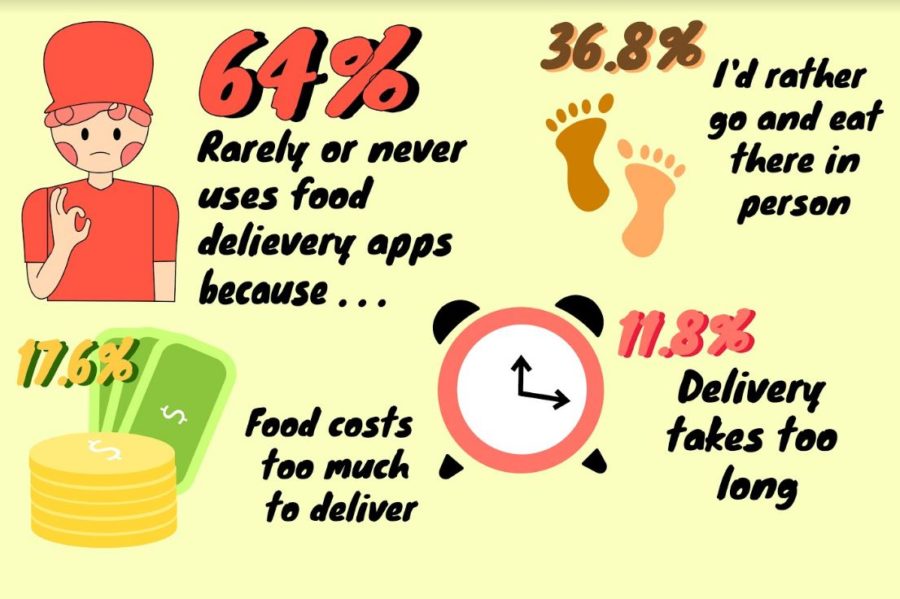Food delivery or food failure? The effects of food delivery apps on Coppell
According to a survey by Coppell High School sophomore Shreya Beldona, 64% of CHS students rarely or never use food delivery apps. These digital services impact local restaurants in many different ways.
May 23, 2019
UberEats it.
DoorDash it.
Postmates it.
With the growing pervasiveness of food delivery apps, phrases such as these have been coined, mimicking the common behavior to turn the names of companies and services into commands.
As companies have adapted to integrate these new services for their businesses, the familiarity with these apps have also increased and are evident in the number of businesses in Coppell that use food delivery apps.
Though these apps might allow restaurants to attract consumers from further areas, these apps affect the physical restaurant.
Changes in restaurants range from areas for online order pickups to fewer chairs and tables to accommodate for couriers from apps like DoorDash, UberEats, Postmates and Grubhub. Extreme cases include cloud or ghost kitchens, where seating is nonexistent and business is conducted only through delivery.
These changes might seem extreme, yet according to Wayback Burgers co-owner Bobby Tanwer in Irving, we can expect to see these changes occuring in Coppell in two to three years.
“From a restaurant perspective, you’re reducing your cost of doing business, and you’re reducing your cost of labor,” Tanwer said. “If you can still maintain the same sales, it’s a very beneficial thing. I do see [ghost and cloud kitchens] coming to Coppell because your generation [Generation Z] will follow these trends that are occuring.”
In fact, as of 2017, the number of orders from 18-34 year olds using food delivery apps outnumbered food delivery apps orders from 35-64 years olds by over 16%. With the revenue of online ordering services expected to increase by over $40 million in the next four years and with the steady growth of food delivery apps, one can expect an increase in the percentage of food delivery apps from 18-34 years.
Even if these changes start appearing in Coppell, some restaurants resist these changes and embrace the family-focused culture of Coppell by not partaking in the usage of food delivery apps.
The avoidance of food delivery apps, however, sheds light on some of the disadvantages of food delivery apps.
“UberEats, Grubhub, Doordash – any one of those apps cinch off any direct customer relations that you have,” J. Macklin’s Grill manager Tony Sirizotti said. “[Coppell] is a family oriented place. Everyone who has eaten here has eaten here before, and it’s nice to be able to come in and know your menu and know your bartenders and servers.”
But taking away from the longstanding tradition of in-restaurant dining is only one of the cons of food delivery apps.
Tanwer’s most prominent concern is the percentage of profits made from online delivery transactions.
Though a business might make a significant portion of its profits from online ordering, profit margins shrink. A restaurant might be making money but may not make as much if they were to refrain from using food delivery apps. This can lead to breaking-even or even losing money.
Yet, Tanwer and many restaurant owners in Coppell continue the use of these apps despite the disadvantages they have.
“[Food delivery apps] basically put your restaurant in everybody’s hands,” Tanwer said. “And then within the platform you have opportunities to put your restaurant above the rest by paying additional fees. So when you open up an app [such as] UberEats or DoorDash in this location, it will pull up the top 10 restaurants. You can pay to be placed at the top.”
Instead of reaching customers only found in the local community, these apps enable restaurant and food establishment owners to reach those who are several miles away.
This feature can be even more valuable to restaurants whose location is not ideal.
With it’s fair share of advantages and disadvantages, the surge of food delivery apps and online ordering seems to be making its rounds to towns across the country. Between maintaining intimate customer connections and leveraging economical advantages, restaurants and businesses will need to weigh the pros and cons of the decision.











